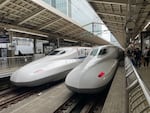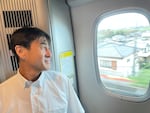
Shinkansen trains prepare to depart from Tokyo Station on Sept. 28, 2024.
Adam Bearne
Stepping onto a Japanese bullet train feels like taking a trip into the future.
The sleek, white cars with blue stripes down the side glide out of stations across the country every three minutes.
The locomotives' pointed noses power passengers up to speeds close to 200mph.
Yet this is not new technology.
Known as the Shinkansen, the train made its first journey 60years ago this month.
The train has been improved since then, of course, with it reaching higher speeds than when it launched in 1964. This speed increase is partly contributed to by carriages that tilt while the train goes around corners.
The train was key to Japan’s recovery from the devastation of World War II, according to Naoyuki Ueno, a manager with the Central Japan Railway Company.
“Thanks to the Shinkansen train, Japan has seen huge growth in its economy. So that’s very, very important for Japanese people,” he said.
Ueno credited the rapid connection between Tokyo and Osaka, the country’s largest cities, for the economic boom.
The Shinkansen cuts a ten hour drive on congested highways down to two hours and twenty-one minutes.
“That’s why a lot of businessmen use the Shinkansen train, and we have had 6.8 billion passengers so far,” Ueno added.
The train is also a point of pride for the country.
“It is a kind of symbol of Japanese techniques, not only about the hardware and software, because the train drivers are well-trained. Even the cleaning staff, they are well-trained, they are proud of their jobs. So that’s why we can operate the Shinkansen train punctually,” said Ueno.
In a delicately balanced network of thousands of trains across Japan, the Shinkansen runs virtually to the second.

Naoyuki Ueno with Central Japan Railway Co. watches the Japanese landscape rush by from a window on the Shinkansen on Sept. 28, 2024.
Adam Bearne
Precision operation
Such is the pride of running on time, an operating company once apologized when a train left 25 seconds early.
The precision of the operation was clear when NPR was invited into the driver’s cab during a Shinkansen ride from Tokyo to Kyoto.
The driver followed the progress of the train along a map showing prominent locations such as tunnels and stations, marked with the time the train should be arriving there.
If slightly ahead of schedule, the driver could ease off the throttle.
Running behind? The driver pushes the train closer to the speed limit.
The pressure was on to stick to a demanding schedule. The train has a 30-second window in which to arrive at the next stop – no more than 15 seconds ‘early’ or ‘late.’
It’s all part of a delicately balanced timetable where travelers rely on accuracy to make tight transfers to other trains.
It was hard to believe that with such punctuality, this Shinkansen wasn’t being controlled by a computer.
Nowhere was the speed more evident than in the cab, where NPR was not allowed to record audio, or take photos or video.
Looking down the tracks as the train rocketed past 170mph was like that moment in a movie when a spaceship goes into warp drive – the world seemed to stretch around you.
Smooth operator
Despite the high speed, the quality of the ride is what stuck with Roy and Leighanne Neese, tourists from Fort Worth, Texas.
“It was wonderful. It’s very comfortable. It went fast. It was smooth,” said Leighanne.
“What really impressed me was how fast it got up to speed and how fast it would decelerate and you didn’t really notice it. It was truly impressive,” Roy said. “The seating was comfortable. The staff on board was friendly, helpful. You couldn’t ask for a better experience,” he added.
Anyone who might have had motion sickness on a train before will be relieved to know that all the seats on the Shinkansen face forward, with staff able to rotate them when the train reaches its destination in preparation for the return journey.
A Lone Star State Shinkansen?
The Neeses could get the chance to ride the Shinkansen in their home state of Texas if Amtrak gets its way.
The company was recently awarded a nearly $64 million grant to continue planning a high speed rail line between Houston and Dallas.
At a conference in Texas earlier this year, Amtrak’s head of high speed rail, Andy Byford, told rail fans that not building the long-proposed line would mean missing out on a chance to transform what’s now a drive that takes over three hours.
“You would be forgoing the opportunity to get from Dallas to Houston in 90 minutes, you would be forgoing the opportunity to take 12,500 cars a day off the I-45,” he said. “You would be forgoing the opportunity to have something which I think would kickstart a rail revolution in the US.”
The planned route also includes a stop in College Station to serve Texas A&M University.
Byford went on to say that a successful bullet train in Texas would lead other city pairings to plan their own versions in order to remain competitive.
Like any big infrastructure project, it faces opposition.
The plan is the “biggest bait and switch that’s ever been put on taxpayers,” according to Trey Duhon of Texans Against High Speed Rail.
That’s because it was originally conceived as a privately funded project by a consortium known as Texas Central.
Now, with Amtrak’s involvement, taxpayer money is on the line in a project that is expected to cost billions of dollars to complete.
Duhon told NPR that his group’s name is a misnomer, that they don’t actually oppose all high speed rail, just this project.
It would be better to build a high-speed rail line along the existing I-45 corridor, he claimed.
“We think that would be a much better option than coming out to Waller County, Grimes County, Madison County, all these counties, and just tearing up land,” added Duhon.
Texans Against High Speed Rail represent many landowners in the area of the proposed route who are facing the possibility of being forced to sell their land if eminent domain rules are used.

Passengers prepare to board a Shinkansen train at Kyoto Station on October 4, 2024.
Adam Bearne
Freedom
Politics aside, another tourist from Texas who experienced the Shinkansen told NPR he wanted to see it built in his home state, citing a very Texan value.
“I think it would give freedom to a lot of people,” Jared Wilken said, outside of Kyoto’s main station.
The size of the state makes it impossible to get around without a car, Wilken added.
“It just makes a lot more sense to invest in the infrastructure for the people so they can actually go to these places and see family and friends and have adventures,” he said.
Wilken also wanted to see the Shinkansen come to the U.S. for another reason.
“It seems like we’re a bit in the dark ages,” he said. “Having this technology just right there… it seems like something we should be jumping on.”
Amtrak’s Byford estimates that if approved, a Texan bullet train could be running in the early 2030s, when the Shinkansen turns 70.
Meanwhile, Japan is building the next generation of high-speed trains, which use magnetic levitation to power passengers past the 300mph mark.
Now that really is the future.
The digital version of this story was edited by Treye Greene and produced for the web by Majd Al-Waheidi.